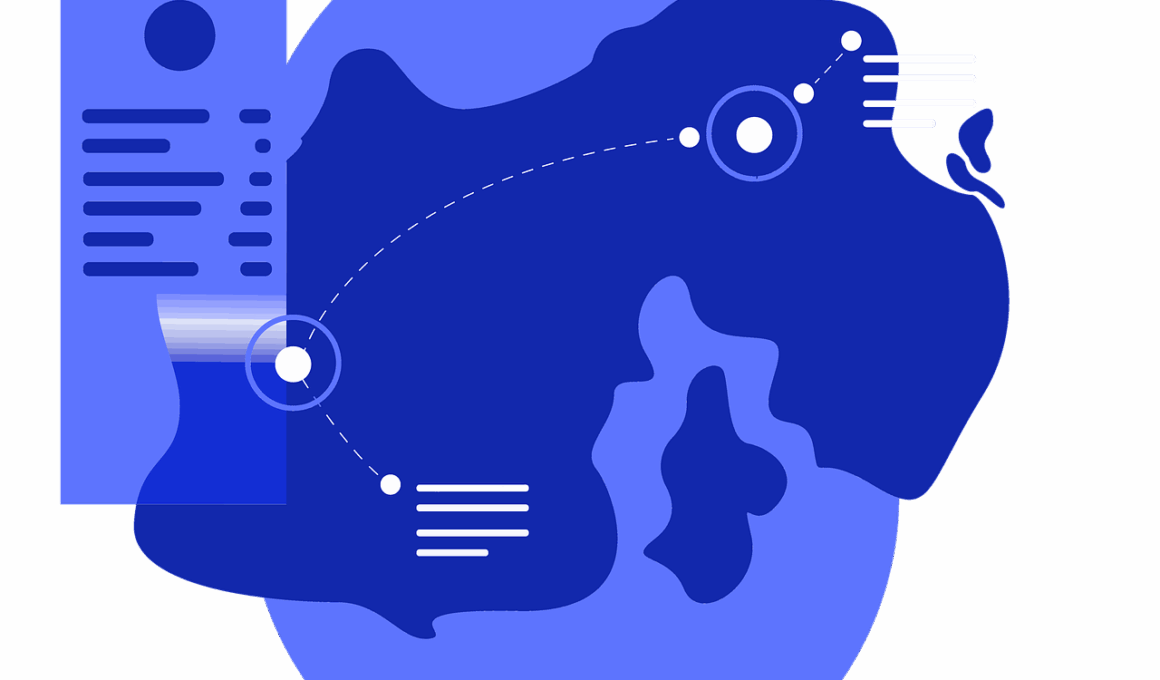Competitive Intelligence Gathering in International Marketing
Competitive intelligence gathering plays a crucial role in shaping international marketing strategies. In the global marketplace, understanding local competition allows companies to build effective positioning strategies. Businesses must collect data on competitors’ strengths, weaknesses, and market tactics. This information can significantly impact crucial business decisions such as new market entry and product launches. Effective competitive intelligence utilizes various methods, including web scraping, surveys, and direct observations. Gathering information from multiple sources ensures a comprehensive understanding of the competitive landscape. Analyzing this data helps businesses identify market opportunities and potential threats. Leveraging intelligence enables organizations to adapt their marketing tactics in real-time, improving overall competitiveness. By understanding consumer preferences in different regions, businesses can tailor their products to better meet local demands. Informed decision-making led by accurate competitive intelligence can provide a significant advantage, allowing companies to execute strategies more effectively. Ultimately, competitive intelligence empowers businesses to maintain a competitive edge in international marketing, ensuring sustained growth across diverse markets.
Understanding the components of competitive intelligence is vital in international marketing efforts. There are generally three major components: data collection, analysis, and dissemination. Data collection involves assembling information from a variety of sources, such as public databases, competitor websites, and industry reports. The next step involves analyzing the data to derive insights and trends that would impact marketing strategies. This analysis can identify gaps in market offerings, price adjustments, and innovation opportunities. The final phase is dissemination, which ensures that insights derived from this intelligence reach relevant stakeholders. This ensures alignment across teams and informs strategic decisions in real-time. Employing tools like SWOT (Strengths, Weaknesses, Opportunities, Threats) analysis can further refine these insights. Technology advancements have made obtaining competitive intelligence more efficient. Online platforms provide immediate access to competitor activities, allowing businesses to adapt swiftly. Keeping abreast of competitors enables organizations to creatively differentiate their products. Additionally, fostering a culture of continuous learning within the company can enhance responsiveness to market changes. Continuous competitive intelligence gathering ensures that businesses maintain relevance and capitalize on international marketing potentials.
Tools for Gathering Competitive Intelligence
In the ever-evolving global market landscape, having the right tools for gathering competitive intelligence is essential. Various digital tools can streamline the process of information collection and analysis. For instance, social media monitoring tools can track competitors’ online activities and consumer sentiments towards their brand. Tools such as SEMrush or Ahrefs provide insights into competitors’ online search performance and keyword strategies. Additionally, customer feedback platforms can shed light on consumers’ perceptions of competing products. Using Google Alerts can help businesses stay updated on competitors’ news and announcements. Another vital resource is industry reports and market research studies. These documents provide comprehensive data regarding market trends and competitor performance. Documenting findings through dashboards or visual representations can facilitate more straightforward interpretation of data. Moreover, leveraging customer relationship management (CRM) systems can enhance understanding of client interactions and preferences. These tools not only provide detailed insights into consumer behavior but also reveal how competitors are addressing these needs. Integrating various tools into a cohesive strategy can elevate competitive intelligence efforts in international marketing, ultimately leading to informed decision-making and enhanced market positioning.
The role of data analytics in competitive intelligence cannot be overstated. Advanced analytics can uncover hidden patterns in data that might be overlooked during manual analysis. By employing machine learning algorithms, companies can predict competitor behaviors based on historical data. This predictive insight allows businesses to proactively adapt their marketing strategies. Visualization tools can also present complex data in digestible formats, making it easier for stakeholders to grasp competitive trends. Implementing data analytics fosters a culture of informed decision-making, where teams rely on data-driven insights rather than conjecture. Businesses must also remain compliant with local regulations when gathering intelligence, ensuring ethical practices in data collection. Regularly reviewing and updating data privacy policies in relation to competitive intelligence efforts is critical to maintaining credibility. Successfully using data analytics requires ongoing training and development of staff to ensure they are proficient with the latest technologies. As industries continually evolve, so too must the tools and methodologies employed in competitive intelligence. A robust analytics framework strengthens a company’s position by delivering ongoing insights into the competitive landscape, empowering them to seize market opportunities.
Challenges of Competitive Intelligence
While gathering competitive intelligence is invaluable, businesses also face considerable challenges in this endeavor. One significant hurdle is navigating the vast amount of available data. Sorting through irrelevant or misleading information can be time-consuming. This issue is exacerbated by the pace at which market dynamics can change, making timely data collection critical. Additionally, organizations may encounter ethical concerns related to data gathering methods. It’s fundamental for businesses to ensure that their competitive intelligence practices comply with the legal frameworks in place. Missteps can lead to costly legal disputes and damaged reputations. Another challenge involves maintaining a balance between accumulating sufficient data and avoidinginformation overload, which can obfuscate actionable insights. Properly training teams in data analysis can alleviate some of these concerns. Organizations must also invest in technology and resources that streamline the gathering process. An integrated approach combining technology with human intuition can significantly enhance a company’s competitive intelligence efforts. By addressing these challenges, businesses can harness intelligence that drives effective strategic planning in international marketing, ensuring sustainable success.
Ultimately, collaboration plays a decisive role in enhancing competitive intelligence efforts throughout an organization. Encouraging communication between various departments, such as marketing, sales, and product development, can lead to a more comprehensive understanding of competitive landscapes. Each department may possess valuable insights regarding competitors and market trends. Regular cross-departmental meetings can facilitate the sharing of information and ensure alignment on strategic goals. Furthermore, tapping into the network of business partners can also offer unique insights. Collaborating with local stakeholders, such as distributors or suppliers, can help identify regional trends and competitor strategies. Adopting a holistic approach emphasizes the importance of collective knowledge in competitive intelligence. Transparency in sharing information enables organizations to make informed choices quickly. Additionally, utilizing collaboration tools can streamline the sharing of insights across teams. Equally important is recognizing and rewarding employees who contribute useful competitive intelligence, as this fosters a proactive culture. Cultivating teamwork surrounding competitive intelligence elevates the organization’s capabilities in international marketing, allowing it to respond effectively to the ever-changing global market.
Conclusion
In conclusion, competitive intelligence gathering is a vital component of successful international marketing strategies. Businesses that effectively gather and analyze competitive intelligence can position themselves advantageously in the global marketplace. By leveraging data-driven insights, organizations can not only identify emerging trends but also outmaneuver competitors. Investing in the right tools and technologies can streamline the competitive intelligence process, thereby enhancing overall decision-making. However, businesses must also address the challenges associated with data collection, including ethical considerations and potential information overload. Building a collaborative and communicative culture within the organization strengthens competitive intelligence capabilities and ensures that all teams are aligned. Ultimately, fostering adaptability and continuous improvement is key in international marketing. As market dynamics evolve, so must the approach to gathering competitive intelligence. A well-informed organization is better equipped to navigate uncertainty, capitalize on opportunities, and sustain growth. Therefore, a commitment to investing in competitive intelligence strategies will lead to long-term success in the competitive landscape of international marketing.
In this digital age, technology continues to enhance competitive intelligence gathering practices. Organizations must stay abreast of technological advancements to remain ahead of competitors. Embracing new methods of data collection and analysis can set market leaders apart from laggards. Adoption of AI technologies can automate data gathering processes, providing insights without overwhelming teams with manual tasks. By leveraging artificial intelligence and machine learning algorithms, companies can unearth hidden patterns in consumer behavior and market dynamics. These insights direct strategic marketing initiatives, reinforcing a company’s value proposition in diverse markets. Moreover, adopting responsive public relations strategies based on competitive intelligence can help reposition brands positively in the eyes of consumers. Engaging with customers on various platforms creates opportunities for real-time feedback and intelligence gathering. Therefore, companies must develop tactical approaches that incorporate public relations, competitive intelligence, and marketing strategies. Overall, embracing innovation in competitive intelligence can facilitate informed decision-making, broaden customer engagement, and drive sustainable growth in international markets, reinforcing long-term success.


